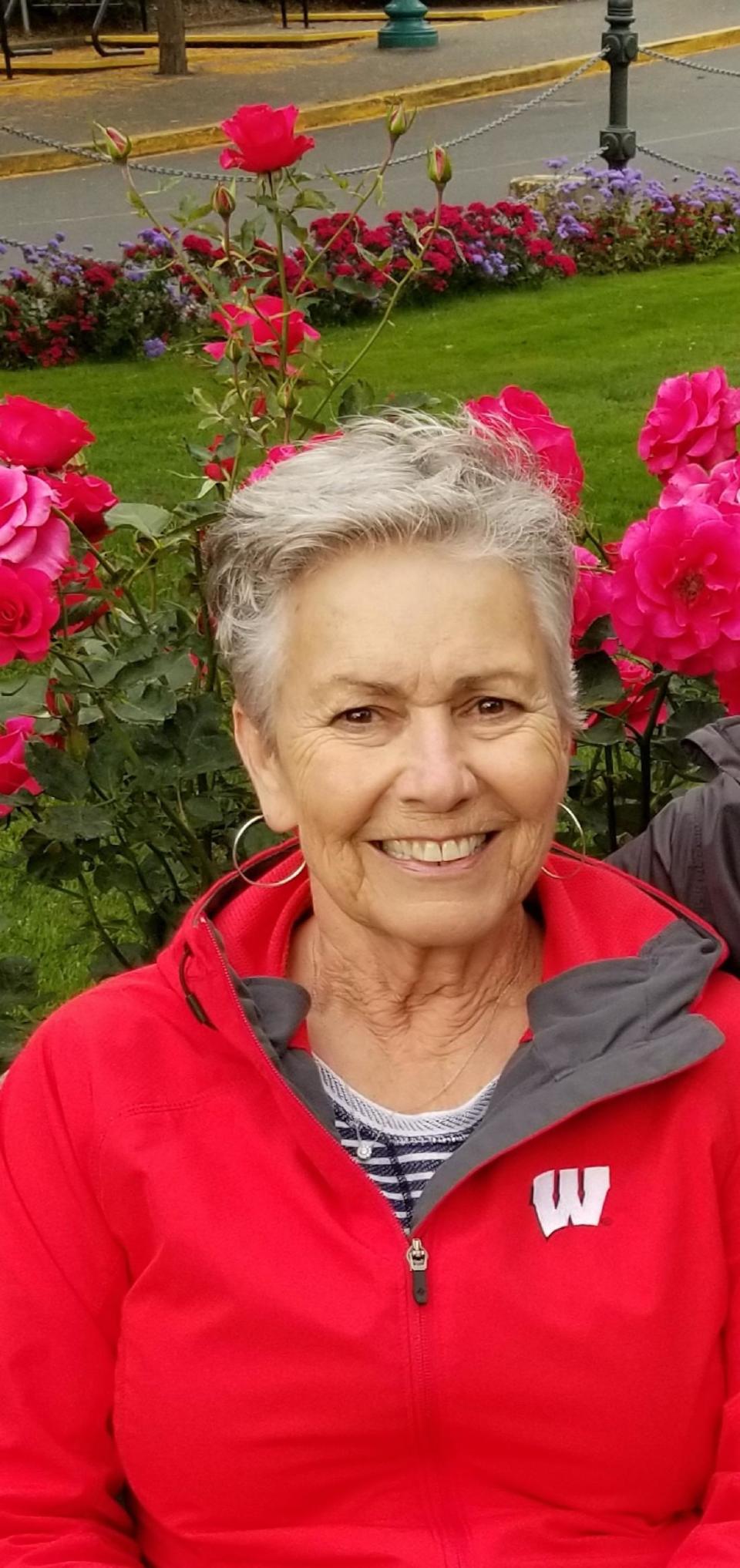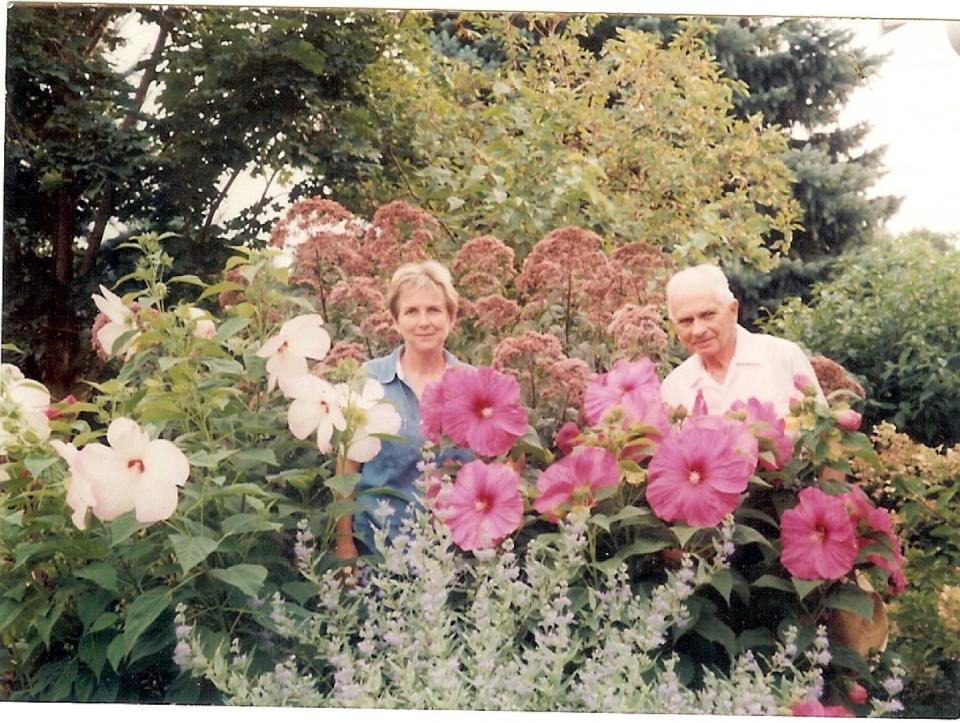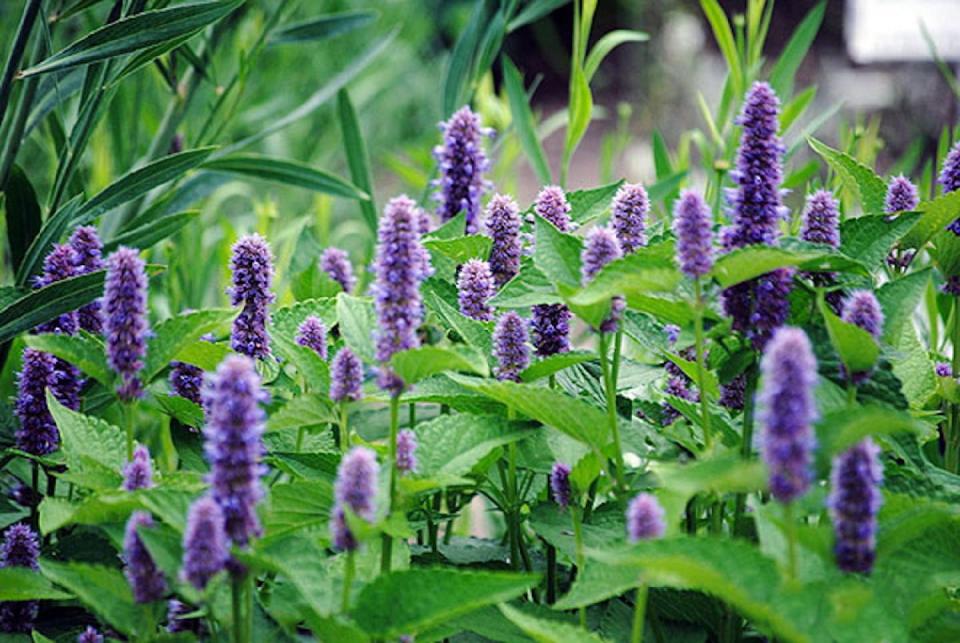How to combine new native plants with perennials in blended gardens
While native plants have become increasingly welcomed at Waukesha gardener Dee Selby’s yard over the past few years, her nonnative purple iris maintains its constant maternal presence.
Split from an iris plant originally grown about 100 years ago by her great-grandmother in Connecticut, the showy tall flower with pointed skinny leaves has accompanied her around the country as she and her family relocated. It’s graced Selby gardens in West Virginia, Ohio, Pennsylvania, Maryland, Oklahoma and two separate yards in Wisconsin. It’s now growing in her daughter’s yard in Johnson Creek as well.
Many flower gardeners share similar stories. People move, and perennials move with them. Gardeners are also increasingly giving native plants a home alongside their faithful perennials. The result is a beautiful blend that’s more nature friendly.
Selby describes her gardens as blended as she’s a big fan of combining natives with modern perennials. She’s not alone. There are classic perennials, shrubs and ornamental trees even some of the most committed native gardeners can’t imagine living without. Think hydrangeas, peonies, lavender, lilacs and crabapples.
Blended gardens combine those sentimental heirlooms and irresistible nonnatives with native plants important for pollinators, insects and birds. Think of it as both rewilding your yard and holding onto some of those dear favorites.
RELATED: How to help Wisconsin's disappearing native bees in your yard
RELATED: Micro prairies: No yard is too small to go with earth-friendly native plants

Blending process
In reality, gardening is a gradual process. Some gardeners work with existing yards that come with new homes; others rework their previous attempts planted years ago before much emphasis was placed on natives.
Half the battle can be removing invasives, unwanted lawn turfgrass and aggressive plants that take over. The tweaking never stops.
Gardeners advance, too, learning and sharing valuable tricks of the trade, often through garden clubs and nonprofit organizations.
In addition to serving as past president of Spring City Garden Club, Selby is a veteran master gardener even though she’s let her designation lapse of late. She’s been gardening for about 60 years after discovering a certain comfort level outside as a teen.
“I’ve evolved into including more natives, coming to the realization that they are here for a reason,” said Selby, still a member of the Spring City Garden Club in Waukesha. “The birds and insects that are here have evolved with them.”
Selby’s gardens have been a work in progress since she and her husband bought her current home 16 years ago. Like most gardeners, she’s never done, with things in constant change from season to season, year to year. Her goal is to always have something in bloom, ranging from early spring’s shooting stars to late fall’s asters.
In recent years, she’s added natives Joe Pye weed, sunflower, coneflower, columbine, butterfly weed, false indigo and cupplant.
In addition to her family iris, she’s retained nonnative daylilies, hydrangeas and hostas.
She places taller natives behind shorter nonnatives with annuals in the very front.
“The taller ones are great for a background toward the more wild area of the yard, and they create a backdrop for my other perennials that I sort of stack smaller to taller,” Selby explained. “Joe Pye weed is a wonderful plant. The butterflies absolutely love it and the bees, all sorts of bees.”
She’s found native orange butterfly weed so “gorgeous,” she’s started raising more from seed. As for annuals in front, Selby typically plants marigolds for bright spots of constant color, and daylilies. Hostas are reserved for shady areas.

Early adopter of blending
Christine Linder is another seasoned Waukesha gardener who’s been blending natives with nonnatives. An early adopter of native plants, Linder is also a member of the Spring City Garden Club, along with the organization Wild Ones for about 25 years.
“Lorrie Otto was in it then. We were in her yard. She was really a neat lady, and she inspired us and got us into natives,” Linder said.
Born near Madison, Otto was a pioneer naturalist who lived in the North Shore suburbs and was the founding inspiration for Wild Ones, according to wildones.org.
In Waukesha, Linder said her blended gardens lean cottage style but also include a variety of woodland natives including wild geranium, mayapple, bloodroot, wild ginger and both red and white trillium.
“I’ve been gardening a long, long time,” she said. “The older you get, you find you want lower maintenance,” she said.
Higher maintenance flowers that require time-consuming deadheading are out in Linder’s yard. She’s also removed most of her oxide daisies, which “took over.”
A specific native/nonnative combination she’s fond of is lamb’s ear Stachys byzantina in front of taller coneflowers. The Stachys byzantina, with its pink/purple flower spikes, is a good choice over other lamb’s ear varieties that rarely bloom.
Lamb’s ear is an evergreen perennial with velvety silver leaves that’s low maintenance and deer resistant.
Lavender is an alternate nonnative perennial that looks good in front of native cones and needs no deadheading, Linder added.
Another combination is nonnative rose campion Lychnis coronaria with native butterfly weed for a striking combination of bright orange and fuchsia contrasting flowers. She loves butterfly weed so much she grows four different varieties.
Linder is also keen on low-maintenance native grasses such as little bluestem and prairie dropseed interspersed with coral bells, hostas, lilies and tall garden phlox paniculatas.
As with many gardeners, Linder has a soft spot for hydrangeas.
“I love hydrangeas, the paniculata varieties. I’m going to put more hydrangeas in,” she said, singling out the ‘Little Quick Fire’ hydrangea as a good dwarf variety with excellent fall leaf colors of red, gold and burgundy.

People love peonies
When evaluating yards and deciding what to edit and how to branch out with natives, educational horticulturalist Zannah Crowe recommended first removing plants deemed invasive by the Wisconsin DNR, which includes a handy list on its website.
Even longtime gardeners should check the list, as some landscape plants that were commonly grown a few decades ago are now classified as invasive. Examples are amur maple, burning bush, lily-of-the-valley, orange daylily, creeping bellflower and various barberry.
When inheriting an existing yard, she also recommended waiting a year to see what pops up before making changes.
Pest control for certain higher maintenance plants is also something to consider. Crowe, of Heyden’s Gardens (formerly Johnson’s Gardens) at 8504 State Road 60 in Cedarburg, suggested reducing the use of pesticides, especially broad-spectrum insecticides that can affect insects and songbirds.
It’s something to consider when evaluating plants such as crabapple trees, with many now bred for disease resistance.
Another area to evaluate is lawn turfgrass that encourages heavy use of fertilizers and herbicides, according to Crowe.
“Replacing a section of your lawn with an area of native plants can be an excellent first step in transitioning to a more balanced home landscape,” she said.
Overall, Crowe said she advocates for natives but added, “We certainly don’t believe that needs to come at the cost of the exclusion of nonnative plants. Even a small, naturalized area can make a big difference.”
Interestingly, Crowe did not hesitate when asked about a favorite nonnative perennial of all time.
“Peonies. People love, love, love, peonies. I think there is a certain nostalgia with peonies,” she replied. “I think it’s because everybody’s grandmother had peonies. It’s fragrant. Every spring, every third person is asking for a peony.”

Like Waukesha gardeners Linder and Selby, Crowe also recommended blending hydrangeas with natives.
“They are a fantastic plant,” Crowe said, adding that it’s hard to find shrubs that are both showy and reliable in Wisconsin’s growing zones.
“The ones that are best for our climate are the panicle hydrangeas. They are just a great, great plant.”
In her own yard, Crowe combines ornamental grasses with native black-eyed Susan and nonnative sedum.
“It stays looking good all the way through winter. Seeds on the black-eyed Susan are a good food source for birds,” she said.
Popular nonnative daylilies also need accent plants to set them off, according to Crowe. One good native to mix in with daylilies is vertical growing native blazing stars or native anise hyssop Agastache foeniculum.
One of her favorites to tuck around natives is nonnative perennial calamint Calamintha nepeta. She described it as a white catmint that attracts pollinators.
“This plant blooms nonstop from midsummer and it goes strong until we get a hard frost. It’s always covered with bees and pollinators,” she said. “I love it to kind of tie the garden together to weave through as a repeating element,” Crowe said.
Another nonnative suggestion for blending is summer-blooming allium Summer Beauty. Crowe said they are excellent perennials that are easy to care for.
As for annual flowers people snap up in May for containers and prime garden spots, many varieties can bring wildlife value as well as constant color.
“Verbenas are probably number one for butterflies,” Crowe said. ‘Meteor Shower’ is a good upright hybrid verbena annual she mentioned, with its round lilac blooms that are heat resistant and attract pollinators but not deer. Deadheading is unnecessary, and it blooms for a long time in part to full sun.
Verbena-like lantana annuals with their funnel-shaped flowers also attract hummingbirds. Annual salvia, tropical shrimp plant and cardinal climber are also good choices for hummingbirds, Crowe said.

Ratio is key
One thing to keep in mind when blending plants is the ratio of native to nonnative. While a 2018 study linked the decline of suburban birds to the presence of nonnative plants, it also found yards proportionally need more than 70% native plants to ensure native bird breeding success and population growth, according to the Smithsonian Conservation Biology Institute.
By keeping nonnatives in the minority, it ensures breeding birds have enough insects to eat. In other words, some leeway exists to incorporate some of those fragrant pale pink peonies that are practically irresistible come June.
Jennifer Rude Klett is a Wisconsin freelance writer of Midwestern life and author of “Home Cooking Comeback,” contact her at jrudeklett.com. Follow her on Facebook at Jennifer Rude Klett: Nonfiction Writer
*********
Garden clubs share their passion
Cheery, colorful flower planters will adorn downtown Waukesha this spring thanks to the Spring City Garden Club, a group of volunteers that has been helping beautify the city for nearly 80 years.
Formed during the Second World War in 1943, the Spring City Garden Club is also holding its upcoming fundraiser plant sale. The sale will be 8:30 a.m. to 1 p.m. June 4 from at St. John Neumann Catholic Church, 2400 Les Paul Pkwy (Highway 59 in southwestern Waukesha). Funds raised will go toward purchasing begonias and trailing vines for the 80 plus containers they will fill to bring lush accents to the streetscape.
“We buy the plants and we supply all the labor. The city does the watering,” said Spring City Garden Club member Christine Linder. “We want to keep the city looking good.”
In winter, the volunteers also create pretty winterscapes in the containers using pine boughs, red dogwood branches and dried hydrangea flowers.
The Spring City Garden Club, at springcitygardenclub.org/, is just one of many such organizations around southeastern Wisconsin. Some have existed for well over 50 years, others, such as the national nonprofit organization Wild Ones: Native Plants, Natural Landscapes, are relative newcomers. Wild Ones officially formed in 1980 in Milwaukee and has grown into more than 90 chapters in 27 states throughout the U.S. with a heavy presence in the Midwest.
RELATED: 2022 Milwaukee area plant sales are starting, many with a focus on native greenery
Following are other garden clubs in southeastern Wisconsin listed by the Wisconsin Garden Club Federation or found online. Websites are listed where available; contacts for others can be found at wisconsingardenclub.org.
Cedarburg Garden Club, cedarburggardenclub.com/
Elm Grove Garden Club, elmgrovegardenclub.com/
Elmbrook Garden Club
Four Seasons Garden Club (Kenosha), 4seasonsgardenclub.org/
Fox Point Federated Garden Club, foxpointgardenclub.com/
Hawthorn Garden Club (Greenfield)
Mayfair Park Garden Club (Wauwatosa)
Milwaukee Art Museum Garden Club, mamgardenclub.org/
Potpourri Garden Club (Franksville), on Facebook.
Racine Garden Club, racinegardenclub.org/
Sheraton Lawns Garden Club (Greenfield)
South Shore Garden Club, southshoregardenclub.com/
Town & Country Garden Club (Cedarburg)
Western Acres Garden Club (Milwaukee)
Whitefish Bay Garden Club, whitefishbaygardenclub.com/
Our subscribers make this reporting possible. Please consider supporting local journalism by subscribing to the Journal Sentinel at jsonline.com/deal.
DOWNLOAD THE APP: Get the latest news, sports and more
This article originally appeared on Milwaukee Journal Sentinel: How to combine new native plants with old favorites in blended gardens

